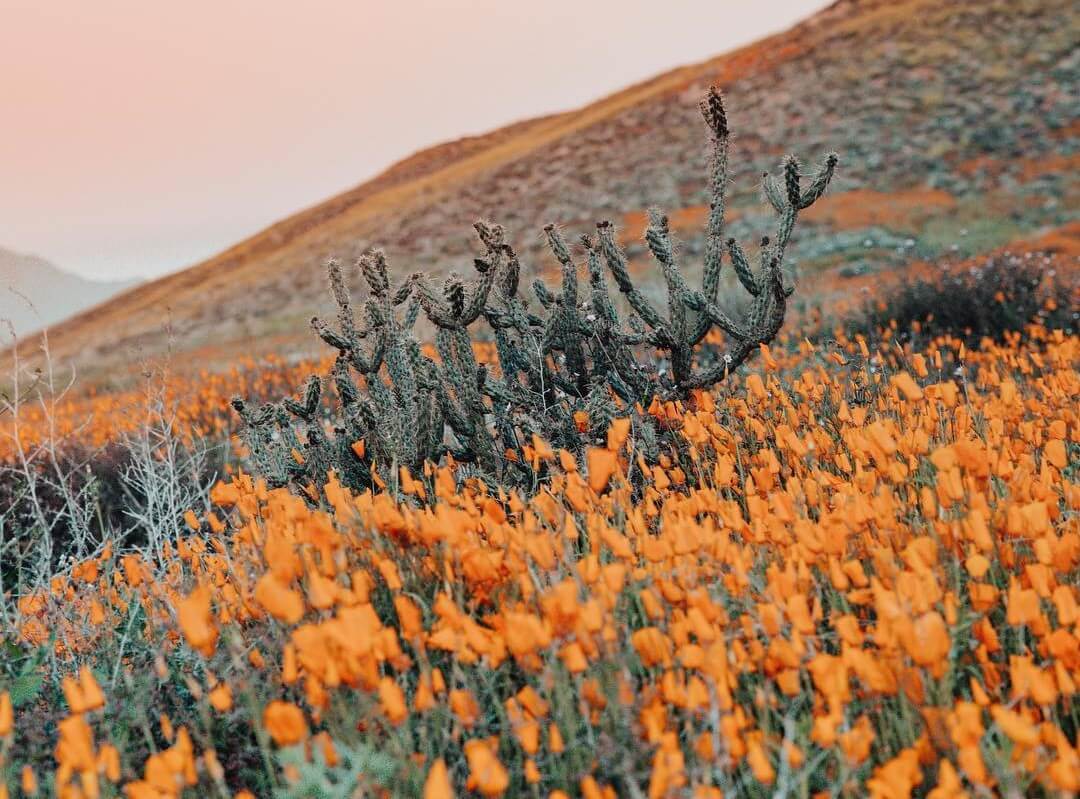
Did Instagram destroy the super bloom?
From fields of poppies to iconic Joshua trees, our quest for likes is becoming a problem.
If you’re on Instagram, you’ve probably heard about the super bloom—or, should I say, seen it.
You know: the seemingly endless fields of poppies, hugging the undulations at Lake Elsinore’s Walker Canyon and other stretches of California’s protected lands. It might have been a fashion blogger posting the photo, lying down among the flame-orange flowers. Or that cute dog you follow, whose owner got a shot of him running through them. Or that not-quite-sure-what-she-does influencer who artfully arranged a handful of the picked poppies into a crown on her head.
You might have “liked” these photos. You might have even thought to yourself, “Next year I’m def booking a trip to the Temescal Mountains.” And you wouldn’t be alone (it’s estimated that 100,000 people checked out the super bloom at Lake Elsinore over St. Patrick’s Day weekend).
But if you’re a mindful traveler, there’s something else you might see in these photos: nature tourism gone wild—and not for the better. There are groups that have clearly disregarded signage and trail markings; people who have trampled on the delicate ecosystem; flowers picked—and then discarded—by the very people who are supposedly there to revel in their glory. And it’s almost always for the likes.

(Photo: Unsplash/Zack Dowdy)
“Social media has created a generation of fly-by-night fad-gramming, with complete and utter disregard for nature or assuming any kind of responsibility,” says the (anonymous) founder of @joshuatreehatesyou (JTHY), an Instagram account that patrols social media to call out destructive activities in Joshua Tree National Park.
It’s one of many accounts that have, ahem, blossomed in the aftermath of #superbloomapocalypse2019 (like @thesuperbloomhatesyou), but it’s not a problem limited to the super bloom—from @yosemitehatesyou to @publiclandshateyou, more and more accounts are reminding ‘gram-happy visitors to channel the “leave no trace” ethos when they’re off chasing selfies.
“Social media has created a generation of fly-by-night fad-gramming, with complete and utter disregard for nature.”
Joshua Tree—with its proximity to influencer-filled Los Angeles—is a prime example of the ways that Instagram culture has impacted some of the country’s most iconic parks. “Destroying Joshua trees out of ignorance has become an Instagram craze and an enormous problem. It’s quite literally an Instagram fad to take photos while hanging or climbing on Joshua trees,” explains the JTHY founder, noting that the plant better known as the yucca palm is close to being added to the endangered list. (Just touching one is technically a violation of city and county law.)
“Since the dawn of Instagram, locals have worked tooth and nail to educate Joshua Tree National Park visitors on the inappropriate posts featuring Joshua tree abuse. [These visitors] care not for protecting wildlife, but for whatever gets them the most likes,” the longtime Joshua Tree resident adds. “A selfish culture has taken over, and it’s slowly destroying the National Park.”
If your handstand-in-the-desert or posing-in-the-poppies post is the target of their ire, it’s not that they want to shame you—they just want to educate you (and, by extension, your followers). “If that post stays up, more people see it and the fad continues to perpetuate itself,” explains JTHY’s founder.

(Photo: Instagram/@jessicasample)
And while some of the infractions they’re calling out might be no-brainers (like, really, truly do not go off trail or enter closed-off areas), there are other rules you might be unwittingly breaking, like using drones (“they pose a fire hazard should they crash, and disturb both wildlife and tourists seeking peace and quiet”) or bringing your dog (in Joshua Tree “they must be leashed or confined at all times”).
So how to best be a conscious nature tourist? “It’s the most simple, yet ignored, goal: leave no trace,” says JTHY’s founder. “Before visiting anywhere, research the area’s rules and regulations. They’re there for a reason, not just to take your latte selfie away. Visit park websites, read blogs, stop by the visitor’s center, and read the signs.”
“Last but not least, do not geotag.”
If you’re super bloom-bound, respectful tourism is the name of the game. “Stay on the trails and behind the barriers—trails are not what has already been trampled on. Don’t step or lay on the wildflowers,” explains JTHY’s founder. Yes, pictures are allowed: “If you take a photo that makes it look like you’re laying on a bed of flowers, make it clear that it’s an optical illusion of photography and not what you’re actually doing. Lead by example. And last but not least, do not geotag.”
You can even take it a step further and—gasp!—keep the phone at home. As JTHY’s founder puts it, “Leave the ego behind. Dress for the desert, not for a photoshoot. Leave your phones behind and truly experience nature.” Now there’s an idea worth a hundred likes.




